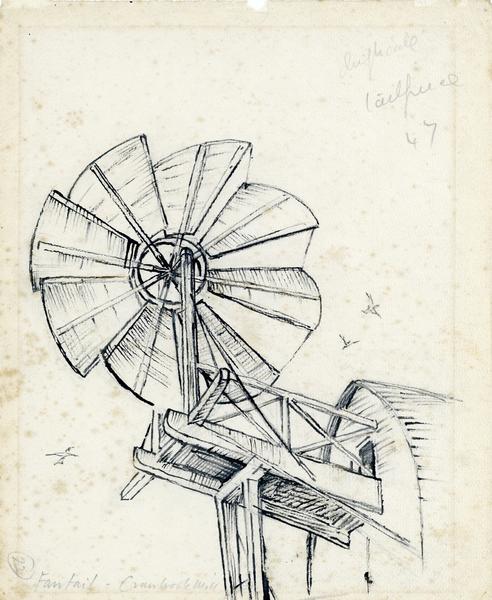| Wind power has a rich history, shaping Europe’s energy landscape for centuries. From the first windmills in the 1100s to the cutting-edge technologies of today, wind energy has been central to humanity’s drive to harness nature’s forces.While many of our users and supporters are already aware of the importance of windmills, we continue to try to find ways to introduce more people to the history of milling, revealing its relevance and ongoing research value. This new project, ‘Mills to Megawatts’, is one attempt to do just that, while working to produce information that we hope is also interesting for the most accomplished mill expert. |
 |
| The fantail of Union Mill, Cranbrook, drawn by artist Vincent Lines c 1950. In this project we have the opportunity to draw attention to gems like this, and use them to explain to the general public what a fantail is and who invented it – DUMC-005 |
| A History With Deep Roots |
| For hundreds of years, people have used wind and water to power essential machinery, like grinding grain into flour, as well as myriad industrial processes. But it wasn’t until the late 1800s that pioneers began experimenting with wind and water as sources of electricity. By the 1970s, renewable energy began gaining momentum, setting the stage for today’s wind energy industry. |
 |
| These wind energy conference proceedings were donated to us by Peter Musgrove. |
| Even in the 1880s, there were concerns about the exhaustive and price-sensitive supply of fuels such as coal. In 1881, William Thomson (Lord Kelvin) spoke at the annual British Association for the Advancement of Science meeting about the potential of generating electricity from wind as well as water. He said:The subterranean coal-stores of the world are becoming exhausted surely, and not slowly, and the price of coal is upward bound—upward bound on the whole, though no doubt it will have its ups and downs in the future as it has had in the past, and as must be the case in respect to every marketable commodity. When the coal is all burned; or, long before it is all burned, when there is so little of it left and the coal-mines from which that little is to be excavated are so distant and deep and hot that its price to the consumer is greatly higher than at present, it is most probable that windmills or wind-motors in some form will again be in the ascendant, and that wind will do man’s mechanical work on land at least in proportion comparable to its present doing of work at sea. |
 |
| Sir William Thomson, Baron Kelvin. |
| Even now it is not utterly chimerical to think of wind superseding coal in some places for a very important part of its present duty—that of giving light. Indeed, now that we have dynamos and Faure’s accumulator, the little want to let the thing be done is cheap windmills. The probable cost of dynamo and accumulator does not seem fatal to the plan, if the windmill could be had for something comparable with the prime cost of a steam-engine capable of working at the same horse-power as the windmill when in good action. But windmills as hitherto made are very costly machines; and it does not seem probable that, without inventions not yet made, wind can be economically used to give light in any considerable class of cases, or to put energy into store for work of other kinds.(Source: Report of the British Association for the Advancement of Science, 51st Meeting, 1881) |
| A Collaborative Effort Across Europe |
| The Mills Archive Trust, with support from the Council of Europe and the European Union, is working alongside global partners like the World Wind Energy Association, the Nordic Folkecenter for Renewable Energy, and the German Windpower Museum. Together, we are showcasing wind energy’s evolution, from ancient innovations to the groundbreaking inventions of today. |
 |
| View from the top of a wind turbine, Peter Musgrove collection. |
| The People Behind the Power |
| At the heart of this story are the people—visionaries, innovators, and communities whose perseverance has made wind energy a vital source of power for Europe and the world.Edward Lancaster Burne (1869-1946) is one such person. An engineer by trade, he was an early UK pioneer in generating electricity from the wind during the 1920s – 1930s. Lancaster Burne began experimenting with small wooden windmills in his garden, which he developed to power the lightbulbs in his home. He went on to patent several early electricity-generating wind devices. His daughter, Lavender, recalled fondly her father’s experiments, which we imagine were viewed with some consternation and amusement by their neighbours. We have records created by Lancaster Burne, such as his original technical drawings and photographs of his prototypes. We have catalogued, conserved, repackaged and digitised these records.It was magic!…No more candles to read by in bed, no smelly oil lamps to clean, just press a switch and there was a light. We felt very superior, for our light came from a windmill at the end of the garden – Lavender Burne |
  |
| E Lancaster Burne and the pamphlet advertising his wind turbines. |
| Peter Musgrove is another important figure, whose work began in the 1960s to develop wind energy including advocating for offshore wind. He co-founded the British Wind Energy Association in 1978, which became what is now known as RenewableUK. We now have Peter’s archive and his books. |
| Join us in Shaping the Story |
| This journey is far from complete! We’re building an interactive map that highlights key events, inventions, and figures throughout Europe’s wind energy history. We invite you to contribute—if you know of a significant individual, event, or place related to wind energy, we want to hear from you. The map will continue to evolve with your input, ensuring this story reflects the contributions of many. |
| Explore the Interactive Map |
| Click here or on the image below… to start exploring the interactive map. While still very much a work in progress, it is growing with each new contribution, offering a fascinating look at the evolution of wind energy.If you notice that an important nugget of information is missing – or something needs correcting – please get in touch. Also, if you have a view on how we should present the information so that it remains user friendly as the content grows, just let us know.We are also keen for help with finding images to go with the entries, prioritising images available on our archive catalogue, or where these are absent, assistance in sourcing images with the necessary copyright permissions. |
 |
| Click the image to start exploring the map. |







